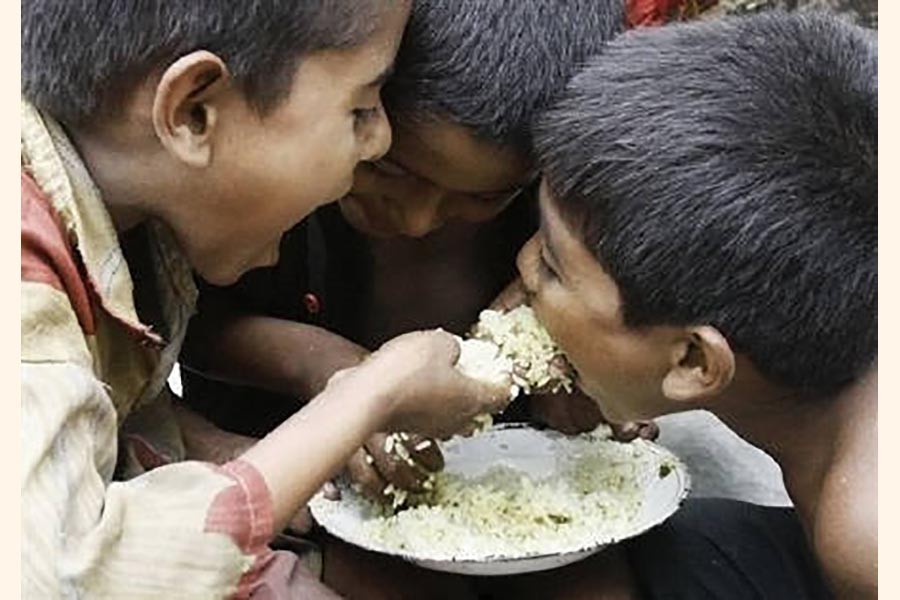The socio-economic impacts of ultra-poor progarmmes - such as those initiated in Bangladesh and elsewhere - are available in empirical tests. The innovative scheme, as many readers are aware, is just not an asset transfer to the poor. It combines the provision of income generating assets with an integrated approach embracing multifaceted training on entrepreneurial activities, health and nutrition, social and political awareness-- over a period of two years. But very little attempt has so far been made to examine the nutritional effects of the programme. For example, the million dollar question remains: does such intervention help improve nutritional status in poor households living below $0.60-$0.70/day? Second, does the knowledge gained by target households somehow spill-over to non-target households so that the latter group reaps without sowing?
Inclusion of malnutrition into the analysis of impact assessment of an asset transfer warrants attention as available empirics are replete with ramifications of malnutrition. For example, malnutrition is a major contributor to child mortality in Bangladesh where about 40 per cent of children younger than 5 years of age in rural Bangladesh are underweight while 28 per cent of women are reported thin with Body Mass Index <18.5. Inadequate nutrition increases the probability of contracting infectious diseases, stifles cognitive development and leads to growth faltering for children under 5. Again, malnourished adults are prone to chronic illness such as high blood pressure, diabetes and heart disease accounting for economic cost of 10 per cent of lifetime earnings.
But why the issue of malnutrition had to take a back seat in earlier assessments of the programme for the poor? Perhaps the very technicality of the issue kept researchers away from dwelling on that including the problem of measurement of health outcomes. However, Wameq A Raza and Ellen Van de Poel of the Institute of Health Policy and Management of the Erasmus University (Rotterdam) embarks on the first ever attempt at evaluating the effects of participants of Challenging the Frontiers of Poverty Reduction (CFPR) on nutritional status among household members - both targeted or non-targeted. The researchers used random data trial covering 26,997 households and panel data over a four year period. The additional beauty of this study seems to be that the authors not only evaluated nutritional status among the ultra-poor (UP) participating households but also estimated the spill-over effects of the programme on other-poor (OP) and non-poor (NP) households.
The findings from the study appear to be quite interesting and insightful. According to the researchers, there is a considerable impact on the nutritional status among UP household members. The impact is most pronounced for children under 5. This is good news as Bangladesh has very high infant mortality rate although the rate has been falling over time. In addition to improvement in the weight-for-height and weight-for-age indicators, the likelihood of wasting and being underweight reduces by 8 and 19 percentage points, respectively. Again among 6-19 years age group, the likelihood of thinness drops by 4 percentage points, followed by a 10 percentage point reduction in the probability of being underweight. While the gains are generally higher among individuals in female-headed households, the authors find no differences in impact across gender of the specific individual. Nutritional status among adults in ultra-poor households similarly gains from CFPR.
The most interesting part of the study is the spill-over impact assessment of the programme. They find CFPR to generate spill-over effects among non-participating households in treatment areas - the benefits being bagged more by other-poor households than non-poor ones. The magnitudes of the impacts on OP are generally half of the UP households and are typically most pronounced for children. The findings further show that the likelihood of wasting or being underweight reduces by12 and 9 percentage points respectively for children in this group. The probability of thinness reduces by 4 percentage points among the 6-19 year olds. Individuals in female-headed households gain the most. While the gains in nutritional status among children under 5 are more favourable towards females, that of the males aged 6-19 years are far better.
What are the reasons behind this or what are the pathways? Results indicate that increased duration of breastfeeding and vitamin A supplement among both ultra-poor and poor let this happen through awareness creation. For adolescents and adults in ultra-poor households, several factors contribute to the improved nutritional status. In addition to the rise in income as shown by different studies, there is evidence of improved food security, lower likelihood of falling ill and improved hygiene practices. For the other poor, results show improved food security and improved hygiene practices.
The authors however, say that their study is not without limitation. But the message following from their hard work is that CFPR not only has considerable impact on the nutritional status of its participants - most notably for children, but also creates positive spill-over effects among non-participants. Spill-over effects are about half the size of the effects on participants. The spill-over effects, especially among infants (through increased duration of breastfeeding) are driven by behavioural changes without financial incentives. The operation of CFPR over a two year period plays a key role in instilling the message among the participants, ultimately leading to behavioural changes.
Abdul Bayes is a former Professor of Economics at Jahangirnagar University. Abdul.bayes@brac.net


